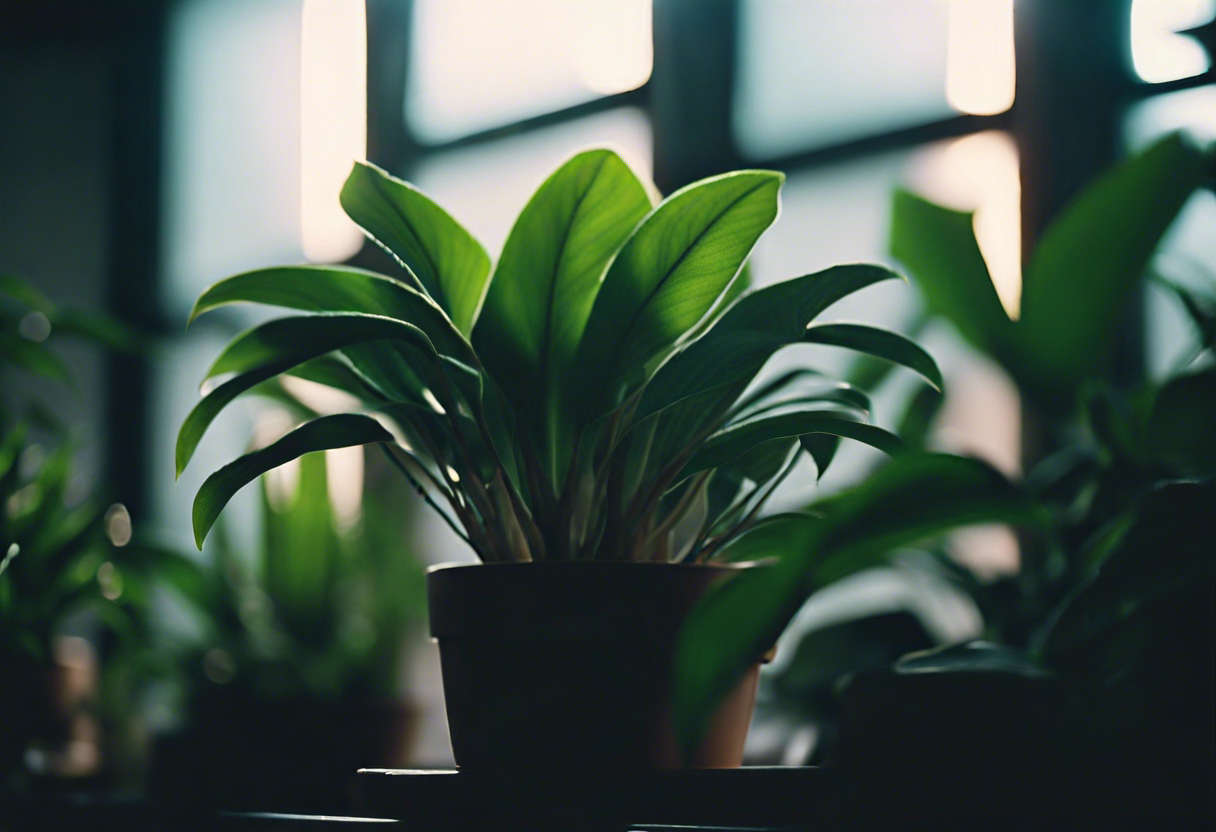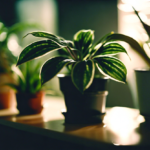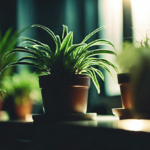The Best Indoor Plants for Low Light Environments
When it comes to indoor gardening, finding the right plants for low light environments can be a challenge. However, with the right knowledge and careful selection, you can create a thriving green oasis even in the darkest corners of your home. Here, we will explore some of the best indoor plants that can thrive in low light conditions.
1. Snake Plant (Sansevieria): Also known as Mother-in-Law’s Tongue, the snake plant is a popular choice for low light areas. It has striking upright leaves that have a dark green color with yellow or white stripes. Snake plants are easy to care for and can tolerate long periods of neglect, making them perfect for busy individuals.
2. ZZ Plant (Zamioculcas zamiifolia): The ZZ plant is another excellent choice for low light environments. It has thick, waxy leaves that store water, allowing it to withstand drought conditions. This plant can survive in areas with just minimal light, making it an ideal choice for offices or rooms with limited natural light.
3. Golden Pothos (Epipremnum aureum): The golden pothos is a versatile houseplant that can thrive in various light conditions, including low light. It has heart-shaped leaves with attractive variegation that adds a touch of greenery to any space. Golden pothos is also known to purify the air by removing toxins, making it a beneficial addition to your home.
4. Parlor Palm (Chamaedorea elegans): The parlor palm is a small and elegant plant that can bring a tropical vibe to your home. It can tolerate low light conditions, although it prefers bright, indirect light. With its bushy and feather-like leaves, the parlor palm adds a graceful touch to any room.
5. Dracaena (Dracaena spp.): Dracaenas are a diverse group of plants with various shapes, sizes, and colors. Many dracaena varieties, such as the Dracaena marginata or the Dracaena Janet Craig, are known to thrive in low light conditions. They have beautiful foliage, ranging from dark green to variegated patterns, making them a visually appealing choice for any indoor space.
6. Pothos (Epipremnum aureum): Pothos, also known as devil’s ivy, is a versatile and hardy plant that grows well in low light conditions. Its long trailing vines and heart-shaped leaves create an attractive cascading effect, making it a popular choice for hanging baskets and shelves.
Before bringing any plant home, it’s important to assess the light conditions of the intended location. While these plants can tolerate low light, they still require some indirect light to thrive. Avoid placing them in completely dark areas, as this can lead to stunted growth or even plant death.
Indoor plants in low light environments not only enhances the aesthetic appeal of a space but also contributes to improved air quality and a sense of tranquility. So, whether you have a dimly lit room or an office cubicle, there is a perfect plant waiting to bring some green joy into your life.
The Importance of Light for Indoor Plants’ Growth
Indoor plants provide numerous benefits, from purifying the air to enhancing the aesthetics of your living space. However, one critical factor for their well-being often overlooked is light. Light plays a crucial role in the growth and development of indoor plants. Understanding the importance of light and how it affects your plants is essential for their long-term health and vibrancy.
Light is the primary source of energy for plants through a process called photosynthesis. During photosynthesis, plants convert light energy into chemical energy to fuel their growth. Without adequate light, indoor plants may struggle to carry out this vital process and may display signs of poor health such as wilting, stunted growth, or yellowing leaves.
Different plants require different levels of light intensity to thrive. Some plants, known as low light plants, have adapted to survive in environments with limited light. These plants are ideal for areas in your home that receive minimal natural light, such as north-facing rooms or spaces far from windows. Examples of popular low light indoor plants include the snake plant, ZZ plant, and pothos.
When selecting indoor plants for low light conditions, it’s crucial to consider their tolerance and adaptability to such environments. While certain plants can survive with minimal light, they may not thrive or achieve their full potential. It’s best to choose varieties that are specifically recommended for low light environments to ensure their health and vitality.
While natural sunlight is the ideal source of light for plants, not all homes offer ample natural light. However, there are ways to optimize the light conditions indoors. Placing plants near windows can maximize their exposure to sunlight. Additionally, using reflective surfaces such as mirrors or white walls can help bounce and distribute light more effectively throughout the room.
In situations where natural light is limited, supplementing with artificial lighting is a viable option. LED grow lights have gained popularity for their energy efficiency and ability to provide the specific light spectrum necessary for plant growth. Positioning these lights at an appropriate distance above the plants can mimic natural sunlight and ensure that they receive the light they need.
Proper care and attention to light requirements are crucial for the health and growth of your indoor plants. By understanding the importance of light and taking steps to provide optimal conditions, you can create a thriving indoor garden filled with lush and vibrant plants, even in low light environments.
How to Care for Indoor Plants in Low Light Conditions
Indoor plants are a great way to bring life and beauty into your home, but what do you do if you have low light conditions? Don’t worry – there are plenty of plants that can thrive in these conditions with the right care. Here are some tips on how to care for indoor plants in low light conditions.
-
Choose the right plants: When selecting indoor plants for low light conditions, opt for varieties that are known to tolerate or even prefer low light. Some popular choices include the snake plant, pothos, ZZ plant, and peace lily. These plants have adapted to survive in the understory of forests, where they receive very little direct sunlight. They are well-suited for low light conditions and can thrive even in rooms with few windows.
-
Placement is key: While low light plants can survive in areas with less natural light, it’s important to place them in the right spot. Look for areas in your home that receive indirect or filtered light, such as near a window with sheer curtains or in corners away from direct sunlight. Avoid placing your plants in dark corners or rooms with no natural light at all, as this can lead to weak growth and pale leaves.
-
Monitor moisture levels: In low light conditions, plants tend to grow more slowly, which means they require less water. Overwatering can lead to root rot and other issues. Before watering, always check the moisture level of the soil by sticking your finger about an inch deep. If it feels dry, it’s time to water. Be sure to use well-draining pots and avoid leaving standing water in the saucers, as this can contribute to root rot.
-
Adjust fertilizer routine: Since indoor plants in low light conditions have slower growth rates, they require less fertilizer compared to plants in brighter areas. A general rule of thumb is to fertilize your low light plants about half as often as plants in bright light. Use a balanced, water-soluble fertilizer and follow the manufacturer’s instructions for dilution and frequency.
-
Rotate your plants: While some plants can tolerate low light conditions better than others, it’s still beneficial to rotate them every few weeks. This helps ensure all parts of the plant receive some light and prevents it from leaning towards the light source. Give each side of the plant equal exposure to the available light by turning it 180 degrees during each rotation.
Remember, even though indoor plants in low light conditions require less light, they still need some. If you find that your plants are struggling, consider supplementing natural light with artificial light sources, such as fluorescent or LED grow lights. These can provide the necessary light energy for photosynthesis and promote healthy growth.
With the right plant selection and proper care, you can enjoy the beauty of indoor plants even in low light conditions. By providing them with the right amount of water, adjusting the lighting situation, and paying attention to their needs, you can create a thriving indoor garden that brightens up your home all year round.
The Right Indoor Plants for Different Low Light Areas in Your Home
When it comes to choosing indoor plants for low light areas in your home, it’s important to consider the specific lighting conditions in each room. Different plants have varying requirements for light intensity and duration. By selecting the right plants, you can easily add greenery and natural beauty to any dimly lit space.
For bathrooms and other spaces with no windows, you’ll need to choose plants that can thrive in very low light conditions. One option is the ZZ plant (Zamioculcas zamiifolia), which can tolerate extremely low light levels and still grow well. Its glossy, dark green leaves add a touch of elegance to the space. Another excellent choice is the Cast Iron Plant (Aspidistra elatior), known for its ability to withstand neglect and low light. Its deep green, leathery leaves create a striking visual impact.
If you have a slightly brighter but still low light area, such as a hallway or living room with small windows, there are several plants that can thrive in these conditions. The Snake Plant (Sansevieria) is a popular choice, thanks to its ability to adapt to various lighting conditions. It has long, upright leaves that come in different shades of green, providing a visually appealing focal point. Another suitable option is the Peace Lily (Spathiphyllum), known for its elegant white flowers and dark green foliage. It can tolerate low light but may produce fewer blooms compared to brighter conditions.
For rooms with moderate to low light, such as north-facing rooms, there are even more options available. The Spider Plant (Chlorophytum comosum) is an excellent choice due to its ability to thrive in indirect light. Its long, arching leaves with white stripes add a touch of texture and beauty to any space. The Pothos (Epipremnum aureum) is another versatile plant that can tolerate a range of light conditions. Its cascading vines and heart-shaped leaves make it an attractive addition to any room.
When choosing plants for low light areas, it’s important to remember that they still need some natural light to grow. Even though they can survive in dimly lit conditions, they will thrive better with at least some indirect sunlight. You can also supplement the light by using artificial grow lights if necessary.
There are a variety of indoor plants that can thrive in different low light areas of your home. By selecting the right plants based on their light requirements, you can transform any dimly lit space into a green oasis. Remember to provide some natural light and care for your plants to ensure their health and longevity.
Creative Ways to Increase Natural Light in Your Home for Indoor Plants
If you have indoor plants that require adequate sunlight but your home has limited natural light, there are creative solutions to help increase the amount of light available for your plants. By implementing these tips, you can create an environment that is conducive to the growth and well-being of your indoor greenery.
Firstly, placing your indoor plants near windows is an effective way to maximize natural light. Make sure to position them on windowsills or near windows where they can receive direct or indirect sunlight. Keep in mind that different plants have varying light requirements, so it’s essential to place them accordingly.
Another creative way to enhance natural light in your home is to strategically use reflective surfaces. Mirrors and light-colored walls can help bounce light and distribute it evenly throughout the room. By placing a mirror or two opposite a window, you can effectively double the amount of light your plants receive. Additionally, using light-colored or glossy paint on walls and ceilings can reflect and amplify natural light, benefiting your indoor plants.
Consider using artificial lighting in combination with natural light. LED grow lights are a popular choice among indoor gardeners to supplement the existing light. These lights are energy-efficient and provide the specific spectrum of light needed for plant growth. Place the LED grow lights close to your plants, ensuring they receive adequate light even in low-light conditions.
If you have taller furniture or shelves blocking natural light, consider rearranging them to allow for better light penetration. By moving furniture away from windows, you can optimize the distribution of light and ensure that your plants receive adequate sunlight. Alternatively, you can opt for open shelving units that allow light to pass through, creating a suitable environment for your indoor plants.
Trimming or pruning any large trees or plants outside your windows can also improve the amount of natural light that enters your home. By removing any obstructions, you can maximize the sunlight available to your indoor plants. Additionally, keeping your windows clean and free from dust or grime can significantly increase the amount of light that passes through, benefiting your plants.
Consider utilizing light-reflecting materials such as aluminum foil or reflective films. By placing these materials strategically behind your plants or lining the inside of windows, you can enhance the amount of light that reaches them. This method is particularly useful in areas where natural light is scarce, as it helps redirect any available light towards your indoor plants.
With a little creativity and strategic planning, you can increase natural light in your home to support the growth of your indoor plants. By placing them near windows, using reflective surfaces, incorporating artificial lighting, rearranging furniture, trimming obstructing plants, and utilizing light-reflecting materials, you can create an optimal environment for your indoor greenery. Remember to consider the specific light requirements of your plants and adjust accordingly to ensure their health and vitality.
Conclusion
Maintaining indoor plants in low light conditions can be challenging, but with the right selection of plants and proper care, you can create a thriving green oasis within your home. Understanding the importance of light for indoor plants’ growth is crucial as it guides us in choosing the right plants that can adapt to low light environments.
When it comes to the best indoor plants that thrive in low light environments, several options stand out. The snake plant, pothos, and ZZ plant are excellent choices as they can tolerate minimal light levels and still retain their vibrant foliage. These plants are not only easy to care for but also help improve air quality by removing toxins.
Caring for indoor plants in low light conditions requires attention to detail. While they may not require as much direct sunlight as other plants, it is important to provide them with the available light they need. Rotate the plants regularly to ensure even light distribution, and avoid overwatering as it can lead to root rot and other issues.
The choice of indoor plants for different low light areas in your home is also essential. For dim corners, consider plants like the peace lily or Chinese evergreen, which can thrive in low to medium light conditions. For bathrooms, where natural light may be limited, consider opting for plants such as the Boston fern or the snake plant, both of which enjoy the humid environment.
If you find that your home lacks natural light, there are creative ways to increase it for your indoor plants. Consider placing mirrors strategically to reflect light and brighten up darker areas. Using light-colored walls and furniture can also help bounce light around the space, creating a more luminous atmosphere for your plants to thrive.
Indoor plants can bring life and beauty to any home, even in low light conditions. By selecting the right plants and providing them with the care they need, you can create a flourishing indoor garden that enhances your living space. Understanding the importance of light, choosing suitable plant varieties, and implementing creative ways to increase natural light will ensure the success of your indoor plants. So go ahead, bring the beauty of nature indoors and enjoy the many benefits that come with nurturing indoor plants in low light environments.


